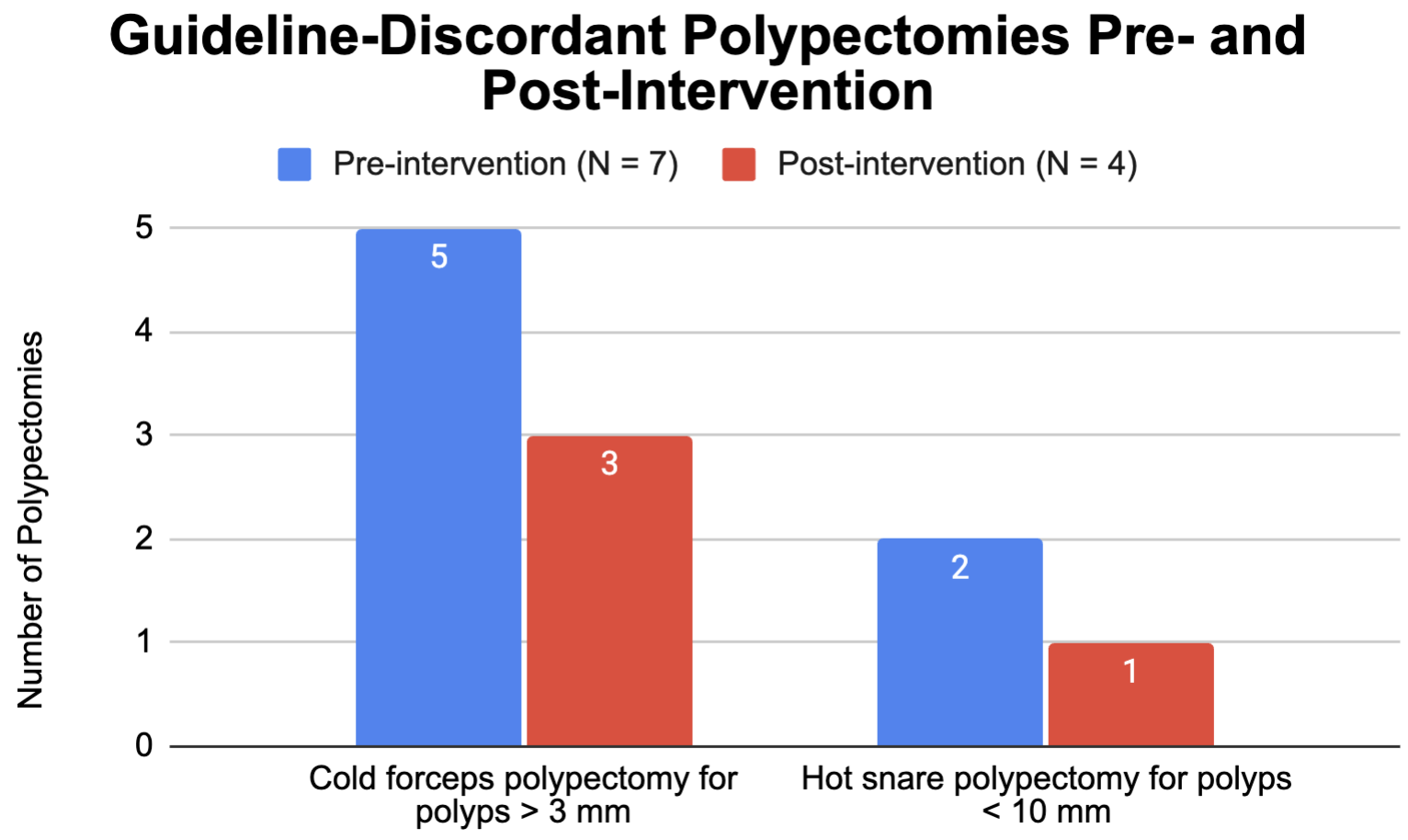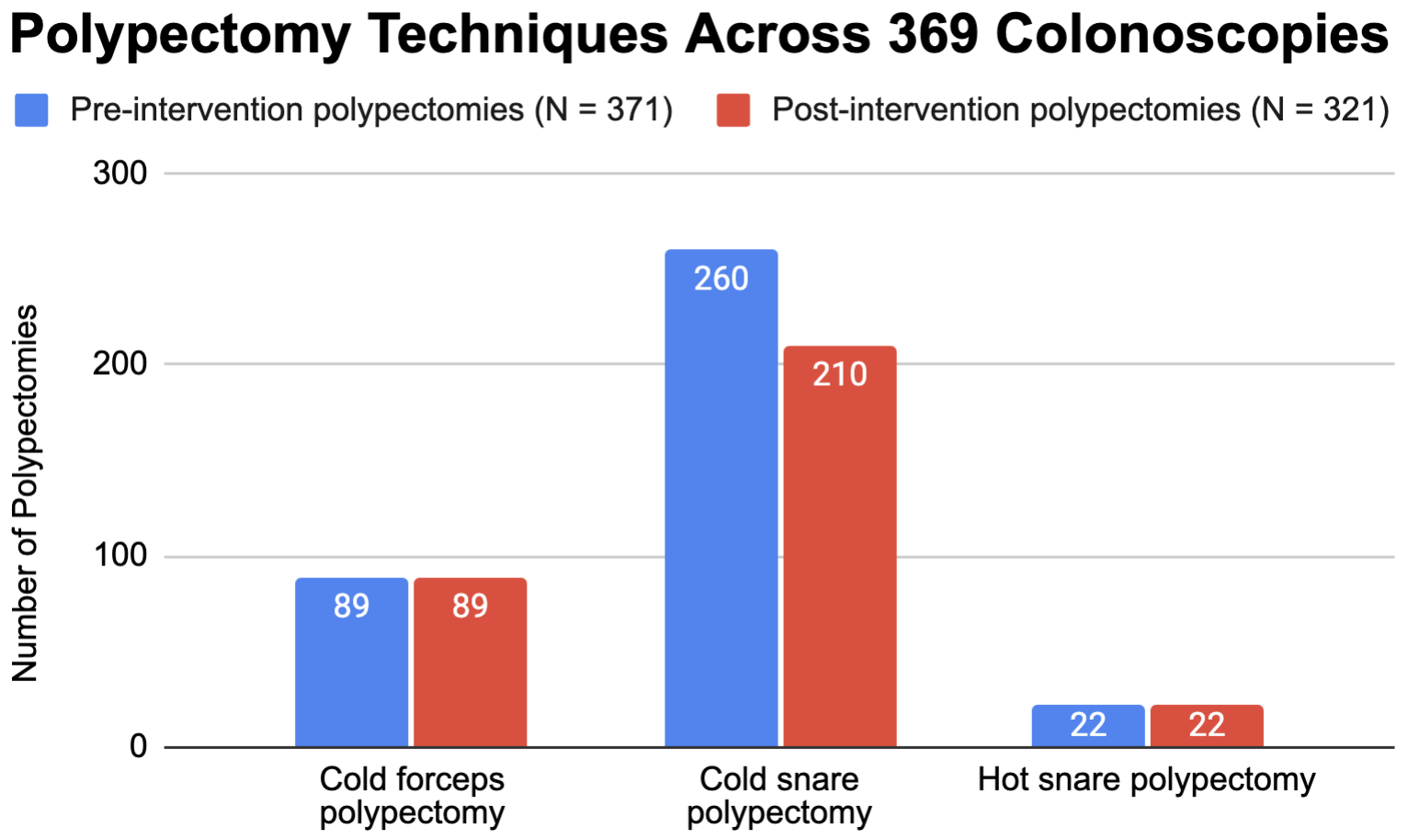Sunday Poster Session
Category: Colorectal Cancer Prevention
P0519 - Polypectomy Guideline Adherence Across 369 Colonoscopies at an Academic Center: A Quality Improvement Project
Sunday, October 26, 2025
3:30 PM - 7:00 PM MT
Location: Exhibit Hall
- MC
Maxwell Charlat, MD
Westchester Medical Center
Valhalla, NY
Presenting Author(s)
Maxwell Charlat, MD1, Emily Shteynberg, BA2, Daniel Basta, MD3, Sarah Rahni, DO, MBA1, Jesse Silverman, MD1, Shireen Pais, MD1
1Westchester Medical Center, Valhalla, NY; 2New York Medical College, Valhalla, NY; 3Westchester Medical Center, Elmwood Park, NJ
Introduction: Colonoscopy and polypectomy remain cornerstone strategies for the early detection and prevention of colorectal cancer. A 2024 American Gastroenterological Association practice update recommends cold forceps polypectomy (CFP) for diminutive polyps < 4 mm, cold snare polypectomy (CSP) for polyps of any size, and hot snare polypectomy (HSP) for lesions > 10 mm. We aimed to increase adherence to guideline-directed polypectomy techniques at our institution via two targeted educational interventions: a journal club discussion on October 7, 2024 and a grand rounds lecture on October 9, 2024. Here we present polypectomy metrics during the five months preceding and following the interventions.
Methods: We conducted a retrospective analysis and identified adults who underwent colonoscopy between May 10, 2024, and March 9, 2025. Procedure reports were reviewed and patient age, sex, polyp size, and polypectomy technique were recorded. After excluding polypectomies where size or polypectomy technique were omitted, statistical comparison between the pre- and post-intervention cohort was performed.
Results: Of the 2,434 adult colonoscopies performed during the ten-month study period, 377 procedures were documented as “colonoscopy with excision lesion” and included for detailed review. After excluding procedures with incomplete data, 369 colonoscopies remained. Among the 185 pre-intervention colonoscopies, a total of 371 polypectomies were performed: CFP was used in 89 cases, CSP in 260, and HSP in 22. Among the 184 post-intervention colonoscopies, 321 polypectomies were performed: CFP was used in 89 cases, CSP in 210, and HSP in 22 (Figure 1). Guideline-discordant polypectomies occurred in 7 cases (1.89%) prior to the intervention, and 4 cases (1.25%) following the intervention (Figure 2). Although there was a reduction in discordant polypectomies from 1.89% to 1.25%, the difference was not statistically significant (P = 0.51).
Discussion: There was no significant difference in polypectomy practice before and after the intervention, suggesting that isolated educational sessions alone are insufficient to drive sustained change in polypectomy practices. In contrast, quality improvement efforts such as adenoma detection rate monitoring have demonstrated that regular, provider-specific feedback is more effective in modifying behavior. Our findings highlight the need for continuous, data-informed reinforcement rather than one-time interventions to meaningfully improve polypectomy quality.

Figure: Figure 1. Polypectomy techniques used across 369 colonoscopies.

Figure: Figure 2. Distribution and character of guideline-discordant polypectomies pre- and post-intervention.
Disclosures:
Maxwell Charlat indicated no relevant financial relationships.
Emily Shteynberg indicated no relevant financial relationships.
Daniel Basta indicated no relevant financial relationships.
Sarah Rahni indicated no relevant financial relationships.
Jesse Silverman indicated no relevant financial relationships.
Shireen Pais indicated no relevant financial relationships.
Maxwell Charlat, MD1, Emily Shteynberg, BA2, Daniel Basta, MD3, Sarah Rahni, DO, MBA1, Jesse Silverman, MD1, Shireen Pais, MD1. P0519 - Polypectomy Guideline Adherence Across 369 Colonoscopies at an Academic Center: A Quality Improvement Project, ACG 2025 Annual Scientific Meeting Abstracts. Phoenix, AZ: American College of Gastroenterology.
1Westchester Medical Center, Valhalla, NY; 2New York Medical College, Valhalla, NY; 3Westchester Medical Center, Elmwood Park, NJ
Introduction: Colonoscopy and polypectomy remain cornerstone strategies for the early detection and prevention of colorectal cancer. A 2024 American Gastroenterological Association practice update recommends cold forceps polypectomy (CFP) for diminutive polyps < 4 mm, cold snare polypectomy (CSP) for polyps of any size, and hot snare polypectomy (HSP) for lesions > 10 mm. We aimed to increase adherence to guideline-directed polypectomy techniques at our institution via two targeted educational interventions: a journal club discussion on October 7, 2024 and a grand rounds lecture on October 9, 2024. Here we present polypectomy metrics during the five months preceding and following the interventions.
Methods: We conducted a retrospective analysis and identified adults who underwent colonoscopy between May 10, 2024, and March 9, 2025. Procedure reports were reviewed and patient age, sex, polyp size, and polypectomy technique were recorded. After excluding polypectomies where size or polypectomy technique were omitted, statistical comparison between the pre- and post-intervention cohort was performed.
Results: Of the 2,434 adult colonoscopies performed during the ten-month study period, 377 procedures were documented as “colonoscopy with excision lesion” and included for detailed review. After excluding procedures with incomplete data, 369 colonoscopies remained. Among the 185 pre-intervention colonoscopies, a total of 371 polypectomies were performed: CFP was used in 89 cases, CSP in 260, and HSP in 22. Among the 184 post-intervention colonoscopies, 321 polypectomies were performed: CFP was used in 89 cases, CSP in 210, and HSP in 22 (Figure 1). Guideline-discordant polypectomies occurred in 7 cases (1.89%) prior to the intervention, and 4 cases (1.25%) following the intervention (Figure 2). Although there was a reduction in discordant polypectomies from 1.89% to 1.25%, the difference was not statistically significant (P = 0.51).
Discussion: There was no significant difference in polypectomy practice before and after the intervention, suggesting that isolated educational sessions alone are insufficient to drive sustained change in polypectomy practices. In contrast, quality improvement efforts such as adenoma detection rate monitoring have demonstrated that regular, provider-specific feedback is more effective in modifying behavior. Our findings highlight the need for continuous, data-informed reinforcement rather than one-time interventions to meaningfully improve polypectomy quality.

Figure: Figure 1. Polypectomy techniques used across 369 colonoscopies.

Figure: Figure 2. Distribution and character of guideline-discordant polypectomies pre- and post-intervention.
Disclosures:
Maxwell Charlat indicated no relevant financial relationships.
Emily Shteynberg indicated no relevant financial relationships.
Daniel Basta indicated no relevant financial relationships.
Sarah Rahni indicated no relevant financial relationships.
Jesse Silverman indicated no relevant financial relationships.
Shireen Pais indicated no relevant financial relationships.
Maxwell Charlat, MD1, Emily Shteynberg, BA2, Daniel Basta, MD3, Sarah Rahni, DO, MBA1, Jesse Silverman, MD1, Shireen Pais, MD1. P0519 - Polypectomy Guideline Adherence Across 369 Colonoscopies at an Academic Center: A Quality Improvement Project, ACG 2025 Annual Scientific Meeting Abstracts. Phoenix, AZ: American College of Gastroenterology.
